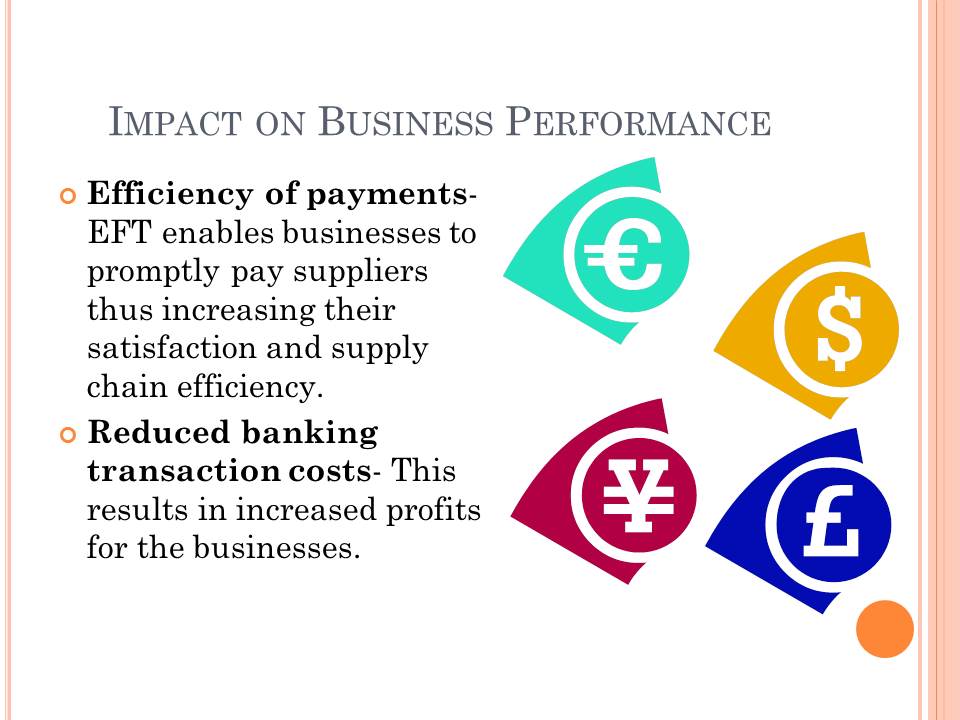Introduction
ICT is concerned with storage, retrieval, manipulation and transmission of digital data. ICT involves software, hardware and systems. In an age dominated by computers, digital data has become integral to business performance (Suki 2010).
This presentation focuses on one component of ICT (e-banking) and its impact on business performance.

E-banking
Definition
E-banking involves delivery of banking products and services to customers via digital channels. Customers do not have to physically visit banks since services are delivered through computer-controlled systems(Arnaboldi & Claeys 2008).

Examples of E-Banking Services
- Credit and Debit Cards;
- Automated Teller Machines;
- Electronic Funds Transfer Systems (EFT);
- Mobile Banking;
- Internet banking.

Factors favouring development of e-banking
- Increased use of computers and the internet across all generations.
- Elimination of set banking hours. E-banking is flexible, customers can transact at any time.
- Lower cost of internet banking.

Advantages of E-banking
Convenience
The use of banking services is separated from location. People can transact with their banks from anywhere in the world (Titrade, Ciolacu, & Pavel Florentina 2009).
Cost Advantage
E-banking costs less than physical/over the counter banking. E.g. ATM withdrawals are charged a fraction of over-the-counter withdrawal charges.
Time saving
Queues and other delaying factors in physical banks are eliminated hence making service delivery faster.
Reduced errors
Computers are less prone to errors than human cashiers.

Disadvantages & Risks
- Lack of personal touch in service delivery
- Security Risk- Online fraud can result when unauthorized persons transact using customers’ accounts (Gemalto 2011) .
- Network Failures– E-banking is prone to internet failures which can disrupt or delay important transactions.

Impact on Business Performance
- Efficiency of payments – EFT enables businesses to promptly pay suppliers thus increasing their satisfaction and supply chain efficiency.
- Reduced banking transaction costs – This results in increased profits for the businesses.
- Improved Financial Management – Businesses can monitor their banking transactions and impact on cash flow position real-time. Previously, they had to wait for bank statements (World Bank 2012).
- Lowering entry barriers in banking industry – Traditional banks with wide branch networks are exposed to competition from new entrants.
Increased supply – chain efficiency reduces supply chain costs.
Real-time information improves financial decision making.
With e-banking, new entrants do not require extensive premises to meet customer needs. They can operate with smaller premises and invest more in ICT.
New entrants into the banking industry also force current payers to be innovative or lose out on their customer base.


The Numbers Speak
- 73% of respondents prefer to interact with their bank online rather than physically (Gemalto 2011).
- 64% of eBankers pay bills online. In 2009, the figure was 19%.
- Banks estimate that eBankers are 15% more profitable than over-the-counter customers (World Bank 2012).

Conclusion
Firms need to adopt e-banking in order to save costs, improve efficiency and maintain competitive advantage(Tennet 2008) .
The major risk associated with e-banking is security. Firms need to ensure they invest in the security of their transactions to avoid losses (Agee 2001).

References
Agee, M 2001, Quantitative Analysis for Management Decisions, Prentice Hall, London.
Arnaboldi, F & Claeys, P 2008, ‘Internet Banking in Europe: A Comparative Analysis’, Research Institute of Applied Economics , 1-28.
Gemalto 2011, Staistics, Web.
Suki, N 2010, ‘An Empirical Study of Factors Affecting the Internet Banking Adoption Among Malaysian Consumers’, Journal of Internet Banking and Commerce, 15 (2), 1-11.
Tennet, J 2008, Guide to Financial Management, Economist Books, London.
Titrade, Ciolacu, B , & Pavel Florentina, F 2009, ‘E-Banking-Impact, Risks, Security’, Universitatea Româno American , 1537-1542.
WorldBank 2012, World Bank Data, Web.